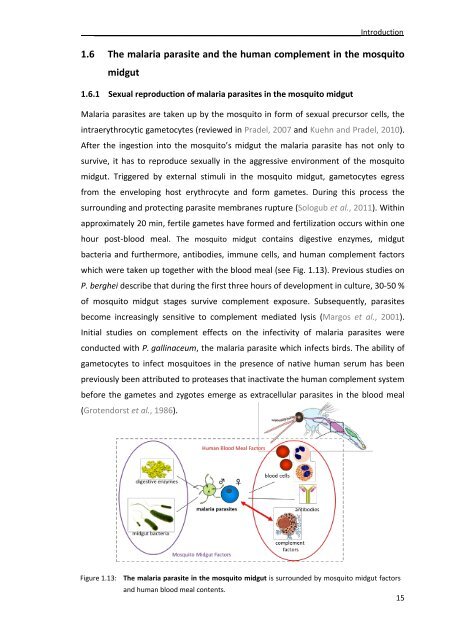Nina Monica Simon - OPUS - Universität Würzburg
Nina Monica Simon - OPUS - Universität Würzburg
Nina Monica Simon - OPUS - Universität Würzburg
You also want an ePaper? Increase the reach of your titles
YUMPU automatically turns print PDFs into web optimized ePapers that Google loves.
________________________________________________________________Introduction<br />
1.6 The malaria parasite and the human complement in the mosquito<br />
midgut<br />
1.6.1 Sexual reproduction of malaria parasites in the mosquito midgut<br />
Malaria parasites are taken up by the mosquito in form of sexual precursor cells, the<br />
intraerythrocytic gametocytes (reviewed in Pradel, 2007 and Kuehn and Pradel, 2010).<br />
After the ingestion into the mosquito’s midgut the malaria parasite has not only to<br />
survive, it has to reproduce sexually in the aggressive environment of the mosquito<br />
midgut. Triggered by external stimuli in the mosquito midgut, gametocytes egress<br />
from the enveloping host erythrocyte and form gametes. During this process the<br />
surrounding and protecting parasite membranes rupture (Sologub et al., 2011). Within<br />
approximately 20 min, fertile gametes have formed and fertilization occurs within one<br />
hour post-blood meal. The mosquito midgut contains digestive enzymes, midgut<br />
bacteria and furthermore, antibodies, immune cells, and human complement factors<br />
which were taken up together with the blood meal (see Fig. 1.13). Previous studies on<br />
P. berghei describe that during the first three hours of development in culture, 30-50 %<br />
of mosquito midgut stages survive complement exposure. Subsequently, parasites<br />
become increasingly sensitive to complement mediated lysis (Margos et al., 2001).<br />
Initial studies on complement effects on the infectivity of malaria parasites were<br />
conducted with P. gallinaceum, the malaria parasite which infects birds. The ability of<br />
gametocytes to infect mosquitoes in the presence of native human serum has been<br />
previously been attributed to proteases that inactivate the human complement system<br />
before the gametes and zygotes emerge as extracellular parasites in the blood meal<br />
(Grotendorst et al., 1986).<br />
Figure 1.13: The malaria parasite in the mosquito midgut is surrounded by mosquito midgut factors<br />
and human blood meal contents.<br />
15

















